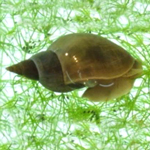MODENDO
 |
Development of toxicokinetics-toxicodynamics models for the assessment of adverse effects of endocrine disruptors |
|
Research
Context and Issues
This projects deals with ecological risk assessment of endocrine active substances (EASs). Current regulations (e.g. EC 1107/2009) require the development of toxicity test methods and data analysis tools devoted to the study of adverse effects of endocrine disruptors on environmental health. These methods should account for the toxicological characteristics of EASs (i.e. active at low doses, complex dose-response curves (e.g. a U or inverted-U shape)). Exposure to EASs should be determined using appropriate analytical chemistry methods to detect EASs at environmentally relevant concentrations.
Objectives
This project aims to:
- develop a generic testing and data analysis approach to predict effects of certain EASs (alkylphenols and organotins) on the gastropod Lymnaea stagnalis using coupled experiments and mechanistic modelling.
- develop innovative methods in analytical chemistry to enable measurement of low concentrations of EASs in water, snail tissues and snail hemolymph.
Methodology
- Toxicity tests are conducted with L. stagnalis over 56 days for a suite of EASs: tributyltin, triphenyltin, linear and branched isomers of nonylphenol, octylphenol.
- Data obtained from chronic toxicity tests are dose-response curves for a suite of endpoints under hormonal control (e.g. growth, sexual maturity, fecundity, quality of progeny) and concentrations of EASs in water and animals.
- These data are used to calibrate a TK-TD model that is based upon the Dynamic Energy Budget (DEB) theory. This model predicts individual performances of exposed animals over their whole life-cycle as a function of EAS concentration over time and environmental conditions (e.g. temperature, available food).
Results
- Experimental factors which might act as confounding factors when assessing effects of EASs on L. stagnalis in laboratory tests have been identified: food type and quality, carrier solvent concentration, snail density. Recommendations have been provided to limit the influence of these confounding factors on the results of toxicity tests.
- Toxic effects of tributyltin, triphenyltin, linear and branched isomers of nonylphenol, and octylphenol on L. stagnalis and its progeny have been characterized.
- A simple and generic mechanistic model named DEBkiss has been developed which describes the life-cycle of L. stagnalis under control conditions, food stress (Jager et al. 2013) and narcotic chemical stress (Barsi et al. 2013). This model is being calibrated with results from toxicity tests with tributyltin to check its ability to describe comprehensively toxic effects of this compound on the life-cycle of the snail. Application of the model to other EASs, validation and documentation will be done in the last part of the project.
- Analytical methods for measuring EASs concentration in snail hemolymph are being developed, which would allow for non-destructive monitoring of internal concentrations over the course of the toxicity test (rather than a single destructive measurement at the end of the test).
People involved
 |
BARSI Alpar, Ph.D. Student Phone : +31 6 49 86 13 84 Email : alpar.barsi@inrae.fr |
 |
COLLINET Marc, Technician Phone : +33 2 23 48 55 29 Email : marc.collinet@inrae.fr |
 |
DUCROT Virginie, Scientist Phone : +33 2 23 48 56 25 Email : virginie.ducrot@inrae.fr |
Partners
Funding and Support
ANSES French Agency for Food, Environmental and Occupational Health & Safety ITMO Cancer the Multi-Institute Thematic research Organisation for cancer research
